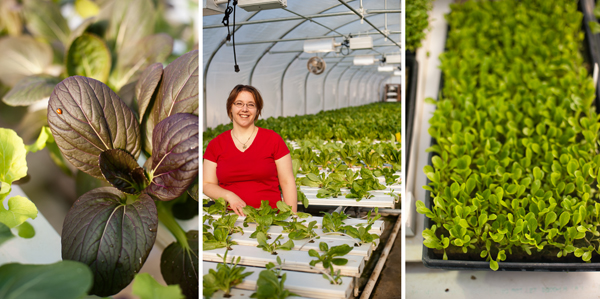
“You’ve got to have a green salad on your menu,” Lenny Russo says. He’s right: Whether or not we order them, we diners expect to see some leafy greens, and we don’t give much thought to how they get on the plate.
That’s easy enough if you’re a restaurateur and the same produce truck shows up at your back door winter, spring, summer, and fall. It’s harder if you’re someone like Russo, chef and owner of Heartland in St. Paul, who has dedicated himself to serving foods from small, local purveyors.
And, yet, when the ground in Minnesota is still hard and cold, there is plenty of green on Heartland’s menu: a delicate tangle of upland cress alongside Russo’s mushroom terrine, a finely diced celery salad with his goose rillettes, even a celery stalk in a weekend bloody Mary. And, a few steps outside Russo’s dining room: heads of lettuce for sale in the Heartland Market. It was that lettuce that stopped me in my tracks one vitamin-deprived January day and made me call Russo to learn his secret to greens in winter.
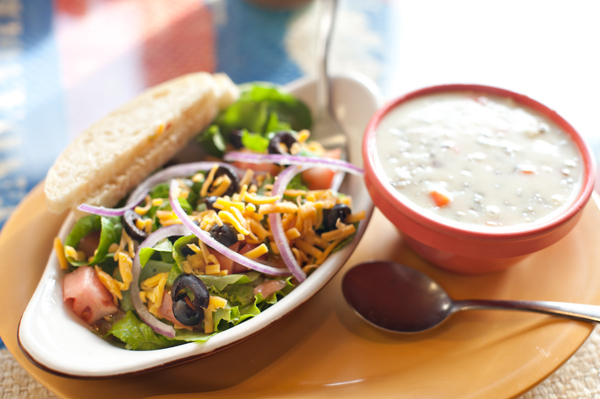
It’s Getting Easier to Be Green
That particular lettuce, I learned, along with the upland cress, tatsoi, and some other greens, comes from LaBore Farms, a hydroponic farm in Faribault, MN. The celery — some of it, anyway, along with some perch — comes from the Urban Farm Project, an aquaculture operation in an industrial area of south Minneapolis. No one small farm can supply all that Russo needs for his ever-changing menu, so he buys from dozens, many of them operating year-round in greenhouses or in a growing number of aquaculture setups.
Russo says the expansion of greenhouse farming in Minnesota has made it much easier to find the winter produce he needs, but adds, “I wouldn’t say that it’s substantial. You have to search high and low. Having greens for sale in the grocery is great, but as far as the restaurant is concerned, [greenhouse greens are] a lifesaver for us…. You really can’t not have greens.”
A lifesaver, huh? Having devoured that local lettuce like a sailor with scurvy, I’d have a hard time calling that an overstatement. So I set out to track down some of Russo’s miraculous winter greens at the source. And, along the way, I found the future of Minnesota agriculture.
Well, the future and the past.
John Erwin is a professor in the department of horticultural science and an extension educator at the University of Minnesota. He says that the fastest growing sector in Minnesota agriculture for the past three years has been in greenhouses — including year-round setups and ones just for the spring and the fall, as well as hydroponics, aquaponics, and more traditional farming. “You have to be careful, though,” Erwin warns, “because that’s a percent. Some of these people can put up one more greenhouse and they’ve increased 100 percent.”
We used to grow more this way, actually. Wagners, Bachman’s, Linder’s — all those local names you associate with picking up a flower arrangement or planting your own garden — they all started as hothouse vegetable growers. A hundred years ago, the Wagner family had a 4,000-square-foot glass building under which they grew tomatoes, cucumbers, lettuce, and more. Not year-round, but for a lot longer than they could in the regular growing season.
But then, says Erwin, President Eisenhower visited Germany and, impressed with the Autobahn, he came home and created America’s interstate highway system.
“When that happened, it allowed vegetables to be shipped here from California and Florida,” Erwin says. “That undercut all the vegetable production and [growers] switched over to flowers.”
Erwin cites several reasons why the new generation of greenhouse growers is coming full circle, back to vegetable production. Number one is that the price of diesel fuel — for trucks driving all those tomatoes from California — has gone up, while the price of natural gas — which greenhouse growers use for heat — has gone down. That hasn’t brought the cost of a local winter tomato into line with the trucked-in ones, but it has narrowed the gap.
Which brings us to reason two: We’ve entered a time when a certain segment of the population is willing to pay more for better food. That greenhouse tomato may not rival a sun-ripened August tomato, but it sure beats one picked green and gassed with ethylene. Also, people like to buy local. Bushel Boy, one of the largest greenhouse tomato growers in Minnesota, took off when they started packing their products in boxes labeled “The Minnesota Tomato.”
That’s the crux of it: Our collective hunger for “the Minnesota tomato” or the Minnesota bunch of arugula and our impatience with the winter cold together make this the right moment for alternative growing, from hydroponics to aquaponics, to covered high tunnels.
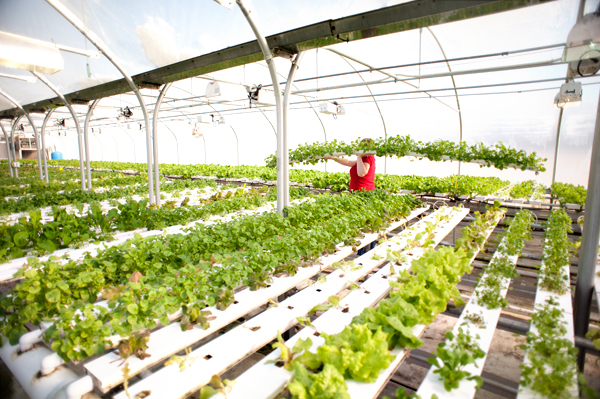
Ladybugs and Winter Greens: LaBore Farms
Michelle Keller decided the time was right for hydroponics years ago, when she was studying plant biology at the University of Wisconsin–River Falls. After trying other career paths, she built her two-bay greenhouse outside Faribault seven years ago. Operating as LaBore Farms, she sells lettuce, cress, arugula, pak choi, and other greens to all the metro co-ops and about half a dozen restaurants, including Heartland. She says she sells out all her product and could easily sell twice as much, if she could just get the financing to double her space.
To get to LaBore Farms, you drive through very typical Minnesota farm country: corn to the left of you, soybeans to the right. But the bristly ground isn’t going to yield anything green for months.
I happened to visit on the singular cold day of this bizarre, warm winter. The sky is a pale, crystalline blue, a 360-degree arc of brightness. It feels as if the sun is shining from everywhere at once. And that means it’s cold: the kind of cold that makes your muscles wrap themselves more tightly around your bones and stiffens the tiny hairs in your nostrils.
“I’ll take this weather over 40 and cloudy,” Keller says, as she invites me to take off my coat. I hesitate, but she reassures me, I’m really going to want to be rid of it. The temperature in the greenhouse is in the upper sixties. She puts a hand in front of a heating vent: And that’s without the heat on at all. Two days ago, in equally bitter cold, the temperature was 75 and she had to open the vents.
Before we enter, Keller asks if I smoke, because there’s a slim chance tobacco residue on hands and clothes can harbor a virus that could wipe out her plants. She also pumps a liberal dose of sanitizer into my degloved hands. “The more anal you are about keeping things clean, the better off you are.”
And there we are, in T-shirts, surrounded by lush, homegrown green. In January. In Minnesota. I confess that I’d like to sit down in the middle of it like Peter Rabbit, and even Mr. McGregor and his hoe couldn’t chase me out.
The greenhouse holds 560 trays, arranged in three rows and packed tightly enough to allow only slim, nimble hips between them. Each tray holds about 18 plants, growing in rock wool, which is, improbably, exactly what it sounds like: spun rocks. An electric pump moves well water from a cistern — a clean, never-used septic tank, sunk into the ground — from the far end of the greenhouse to the near end. And gravity pulls it back down to the cistern again, navigating a two-inch tilt in every tray and a 1.5-foot drop from one end of the greenhouse to the other. Keller changes out the water every two weeks, so her farm uses only 500 gallons of water every 14 days.
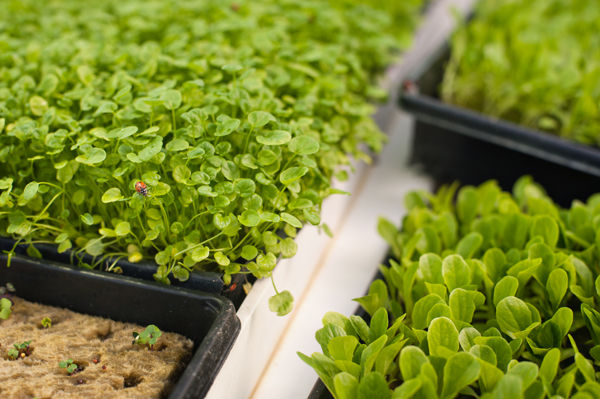
To get started, Keller purchased a turnkey system — the whole kit from trays to pipes to lights — that came with a 2.5-day informational workshop and a grower’s manual. “Basically, you’d better have your head on straight,” she says. Because from there on, it was up to her to make her own mistakes and learn from them. Seven years on, technology has changed so much, she says, that “this is considered an old greenhouse, old technology.”
Today, there’s a tangle of dried grasses on the floor, crawling with ladybugs. Aside from mechanical means — flipping the locations of the trays, rinsing the greens — the ladybugs are the only means of pest control. Keller doesn’t use chemicals, except for a salt-based fertilizer.
LaBore Farms is not, however, certified organic. The fertilizer disqualifies her from organic certification because it does not contain any carbon chains. “Why would I use something my plants don’t need? Lettuce doesn’t need that,” Keller says. “Plus, there’s the insane amount of bacteria in poo-based fertilizer. I couldn’t recirculate my water; I’d have to dump it all.”
Keller’s busiest season comes just as the Minnesota winter truly settles in, in December, January, and February. And then in June and July, when most farmers are in high gear, Keller takes a couple of weeks off. The markets — and Lenny Russo’s salads — are overflowing with local lettuces grown in the dirt and the sun and greenhouse greens don’t feel quite as miraculous as they did in December and January.
Perch Plus Plants: Aquaponics at the Urban Farm Project
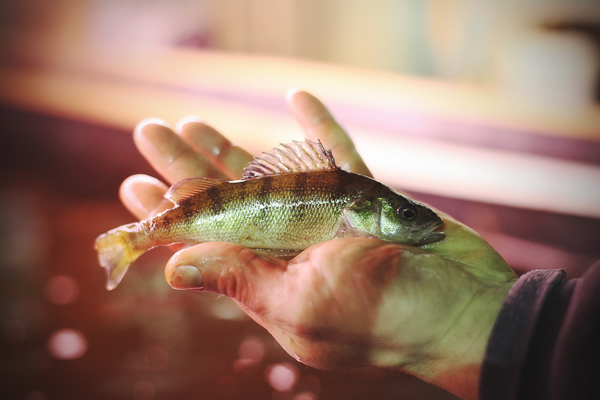
Having tracked Heartland’s lettuce to the source, I set out to find the beginnings of that sprig of celery in my weekend bloody Mary. It may have come from many places — remember Russo has to diversify his sourcing — but it may very well have been grown in a warehouse above a tank full of perch. And those perch, too, sometimes land on Heartland’s plates.
The Urban Farm Project is an aquaponics operation — that means it’s a closed system for raising both fish and plants with the same inputs — in an unlikely warehouse in a tangled industrial area near the intersection of 35W and the Crosstown in South Minneapolis.
Betsy Wieland, who has been the agriculture extension educator in Hennepin County for nearly eight years, never dreamed some of her clients would one day be fish. “I started out working with horse owners and hobby farms, but the urban agriculture scene has grown dramatically,” she says. The Urban Farm Project was the first aquaponics operation to appear in her territory, but it won’t be the last.
“In the city, it’s got to be cost-effective: the price of a square foot of property, versus how much plant material and fish you can grow,” she says. “It will be interesting to see how those economics work out. But we’re going to have to be more innovative with how we grow things, so I’m glad to see a lot of interesting new operations coming on line in the city.”
“One of the interesting things about aquaponics is you can do it in so many different spaces and you can start in a small space with recycled materials and build up,” says Wieland. “There are some really big operations out there, or you can do it in a goldfish tank.”
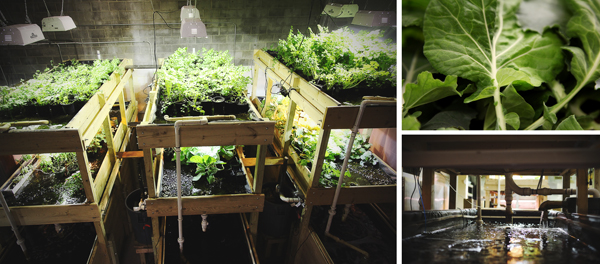
The Fish (and Overall Production) Boom
Chad Hebert started very small with the Urban Farm Project: with a 300-gallon tank in his home. Then he built a small demonstration tank in the Traditional Foods Warehouse, a natural-foods buying club. Now he has five large tanks that take up nearly half of the building, and he has plans to keep growing. Fifty tanks someday, he says, wouldn’t be unreasonable.
In preparation for my visit to the Urban Farm Project, I dug my rubber rain boots out of winter storage and put on my grubbiest jeans. Farming. Aquaponics. Even in South Minneapolis I expected to get dirty. And wet.
Hebert thought this was a hoot — the boots, at least. He was kind enough not to say anything about my jeans. While he was definitely dressed to get work done, he was in regular sneakers. And they were perfectly dry.
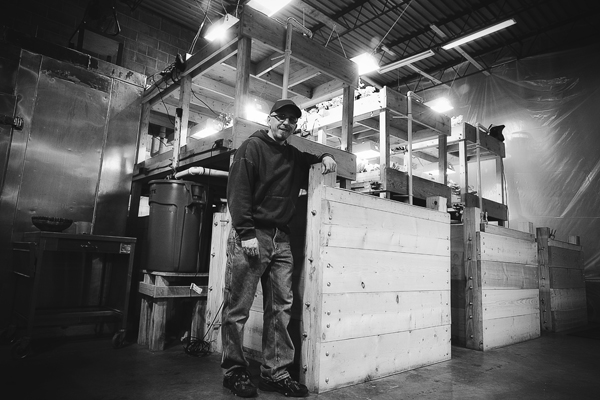
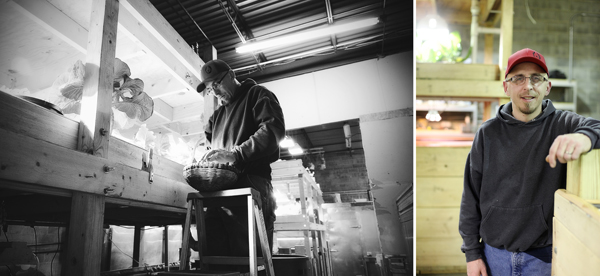
Despite housing 12,000 perch, the Urban Farm Project has a clean and bone-dry cement floor. Hebert and his business partner, Warren Burgess, built the tanks themselves for about $6,500 each. Not nothing, but achievable without venture capital. Each tank looks like a giant wooden bunk bed, with a plastic-lined tank over perch on the bottom and pots of vegetables lined up under grow lights on top. In those pots are collard greens, mustard greens, basil… perhaps a dozen types of plants. Hebert climbs to the top of one bunk, disappears for a moment, then sticks his head back out. “I was going to pick you a strawberry, but they’re not ripe yet,” he says. It is February. Instead, he offers a kumquat and I pop it whole in my mouth.

In among the experimental strawberries and kumquats, Hebert grows lots of celery. This is in part because Russo uses lots of it at Heartland, but it’s also because it’s a fantastic filter plant. It takes bacteria and contaminants out of the soil, so that the water doesn’t pick it back up and carry it back down to the fish tanks.

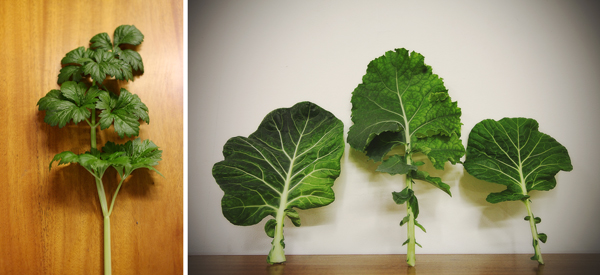
Pumps bring the water up from the fish tanks to the plants. Gravity brings it back down through a natural filter of sand, rock, and coral. Together the tanks hold 10,000 gallons of water, which Hebert never changes out completely, although he does have to replace water lost to evaporation.
A Northern Rival Steals Tilapia’s Thunder
The perch are sorted among the tanks by size. The smallest have just arrived from the hatchery, wiggly little things about the size of my pinky finger. The largest are just about ready to harvest, each weighing about one-third of a pound. In the temperate climate of the warehouse — somewhere in the 60s all year round — they size up fast. “What we do in nine months takes two years outside,” says Hebert.
Why perch when many other aquaculture operations are focusing on tilapia? Number one, perch have a very high conversion rate, requiring only two pounds of food to reach their harvestable size. Tilapia (like those grown at the Baldwin, WI-based Future Farm) also like temperatures in the 70s and 80s, and Hebert is reluctant to spend that much on energy. (The Urban Farm Project heats the air in the warehouse, not the tanks themselves.)
But the other reason is that Hebert himself, a Wisconsinite, loves perch. “I could eat perch twice a day,” he says. “In southeastern Wisconsin, perch is king. They’d take perch over walleye any day.”
Hebert and Burgess work nights, to take advantage of off-peak energy costs. The grow lights come on around 6pm and run until midnight. A typical workday involves checking and cleaning the pumps, testing water quality, and pruning the plants.
When Hebert first started approaching officials in 2009, much of the bureaucracy wasn’t sure what to do with him. The DNR licensed his operation as a fish hatchery (although they raise but do not hatch fish). They are not licensed to process the perch at all and must sell them in the round. The next stop was the Department of Agriculture, which recognized the operation as a farm. The third stop was the city of Minneapolis.
“There we learned that the code doesn’t say yes and doesn’t say no, so [the city is] going to take it case by case,” Hebert says. The city decided to call them a “wholesale greenhouse.” For now, the Urban Farm Project has just one customer, Heartland, and can only sell to restaurants. But Hebert sees his future in selling directly to consumers, perhaps someday with an online pre-order system, and hopes the new Homegrown Minneapolis rules will allow him to set up a minimarket outside the warehouse.
Local Growth, Locally Driven
John Erwin sees a strong future for greenhouse growing of any kind. “The industry is going to continue to grow,” he says. “Anything that ships poorly is a good candidate.” He wants to see strawberries, raspberries, and other fruit grown in Minnesota greenhouses, as is becoming more common in northern Europe.
As the market matures and saturates, he predicts, prices for greenhouse produce will have to drop, and niche products — herbs, for instance — will flourish.
And restaurateurs like Lenny Russo will continue to drive the expansion of greenhouse growing because, as we all know, there has to be something green on the menu and, says Erwin, “The place where more people are willing to pay more for food is restaurants.”
While we’re talking about restaurants and the future, Lenny Russo has a wish list.
Next winter, he’d like some spinach, more varieties of endives, some chervil, and maybe frisee. Minnesota greenhouse growers current and future, you’re our only hope.
Editor’s note: This article was revised on Mar. 12, 2012, to correct Chad Hebert’s last name.

Between heating and water recirculation I wonder about the energy implications of these kinds of operations. Are you aware of any research comparing the total energy consumption per pound of produce for a cold climate hydroponic farm to, say, those vegetables trucked in from Florida?
If you want to see how this sort of thing works on a smaller scale (12-member winter CSA), check out: gardengoddessenterprises.com
Tom, take a look at the link I just sent. Our greenhouse is passive solar, uses about $100 a year in back-up propane heat. Not bad, eh?
Can we elevate the technical vocabulary? “Poo based” could be simply replaced with manure based. Perhaps the use of scatological terminology is designed to differentiate hydroponic production methods and maybe make it seem cleaner or better.
I would guess that cooperative food stores are the most significant Labore customer.